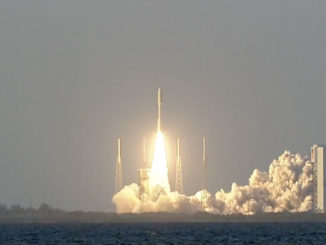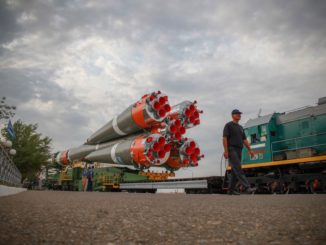An Iranian Simorgh rocket launch carrying an Earth observation spacecraft faltered before reaching orbit Tuesday after analysts used imagery from commercial U.S. satellites in recent weeks to track preparations for the mission.
The rocket lifted off with Iran’s Payam-e Amirkabir imaging satellite before dawn Tuesday at the Imam Khomeini Spaceport, located in Semnan province in the north-central part of the country, according to video of the launch broadcast by Iran’s government-run Press TV television channel.
But Iran’s information and communications minister, Mohammad Javad Azari Jahromi, announced on social media that the rocket failed to reach the speed needed to enter orbit around the Earth due to a failure in the launcher’s third stage. It was the first time Iran has admitted failure in an orbital launch attempt, despite suggestions from U.S. government officials and Western experts that past missions carrying satellites fell short of orbit.
Jahromi tweeted to confirm the launch failure at 0340 GMT Tuesday (10:40 p.m. EST Monday). It is believed the 89-foot-tall (27-meter) liquid-fueled Simorgh rocket took off from its launch pad at the Imam Khomeini Spaceport around 0030 GMT Tuesday (7:30 p.m. EST Monday).
The three-stage Simorgh rocket aimed to place the roughly 220-pound (100-kilogram) Payam-e Amirkabir satellite into an orbit around 300 miles (500 kilometers) above Earth at an inclination of 55 degrees to the equator, according to Iranian state media. The satellite was built at Tehran’s Amirkabir University of Technology, and Payam means “message” in Farsi.
It was designed to take color and black-and-white photos of Earth, according to the Islamic Republic News Agency, the country’s state-run media agency.
Jonathan McDowell, an astronomer at the Harvard-Smithsonian Center for Astrophysics who tracks global space launches, said the Simorgh rocket likely reached a maximum altitude of around 300 miles (500 kilometers) and fall back into the atmosphere over the Indian Ocean.
I modelled yesterday’s Iranian launch failure – it probably reached an apogee of 500 km and fell in the Indian Ocean. Here is a guess at its track. pic.twitter.com/2vPMmyeSpb
— Jonathan McDowell (@planet4589) January 16, 2019
The Trump administration condemned the launch as a stepping stone toward the development of an Iranian long-range missile. In response to Iranian reports of a forthcoming launch, Secretary of State Mike Pompeo warned Iranian leaders not to go forward with the mission, calling the launch “provocative” and calling upon Iran to “cease all activities related to ballistic missiles in order to avoid deeper economic and diplomatic isolation.”
In a Jan. 3 statement, Pompeo said the technology used on Iran’s satellite launchers is “virtually identical” to systems used on long-range ballistic missiles.”
After Tuesday’s launch, Pompeo tweeted that Iran conducted the launch “in defiance of the international community.”
“The launch yet again shows that Iran is pursuing enhanced missile capabilities that threaten Europe and the Middle East,” Pompeo tweeted.
U.S. intelligence officials and independent observers of Iranian arms developments suggest the country is still years away from fielding an intercontinental ballistic missile, or ICBM.
Army Lt. Gen. Robert Ashley, director of the Defense Intelligence Agency, told the Senate Armed Service Committee last March that Iran is “developing more powerful space launch vehicles, boosters that would be capable of ICBM ranges if configured for that purpose.”
But no such long-range weapons are operational in Iran, Ashley said.
“What they have in their inventory are short-range ballistic and medium-range ballistic missiles,” he said. “They do have a space launch vehicle, the Simorgh, which they’ve tested a couple of times. The reliability (of the Simorgh) is not there, so today, if you were to ask me does Iran have an ICBM capability, they do not. Is that aspirational? Yes. Could they take that space launch vehicle and start working it toward an ICBM capability? They could, but that is many years out.”
Tuesday’s launch was the third flight of a Simorgh rocket since 2016, when Iran debuted the new launcher on a suborbital flight. Another suborbital Simorgh launch followed in 2017, and U.S. intelligence officials said the rocket succumbed to a mishap during its second stage burn, a failure not acknowledged by the Iranian government.
The Iranian government suggested earlier this month that they planned two space launches in the coming weeks. Preparations appear to be underway for another launch from a separate, smaller launch pad at the spaceport in Semnan province, according to Jeffrey Lewis, an arms control expert at the Middlebury Institute of International Studies at Monterey.
Thanks to a steady stream of high-resolution images from the SkySat Earth observation satellites owned by Planet, a San Francisco-based company, Lewis and other observers have tracked launch preparations at the Iranian spaceport. With a new image every day, Lewis was able to see vehicle movements and arriving shipping containers as ground crews assembled Simorgh rocket components on the launch mount.
“It was pretty clear to me that a launch was coming,” Lewis said.
The daily observations with Planet’s SkySats offered a rare insight into how Iran prepares for a launch.
“This was a special case for us because we had a lot of warning, starting in December, when the Iranians started talking about the launches,” Lewis said. “Planet was willing to task SkySats, so starting I think on the second of January, we got daily images. Some days it was cloudy, but we got a picture of the launch site basically every day. So we got to watch the preparations in a level of detail we hadn’t seen before.”
A @planet image a day keeps the doctor … very busy. On January 9, Iran erected the gantry at the circular launch pad. There are *two* launch pads at the Semnan Space Center. We are tracking activity at *both*. @missile_manyak @DaveSchmerler pic.twitter.com/ZOgLYZ3qyf
— Jeffrey Lewis (@ArmsControlWonk) January 9, 2019
Similar preparations have been observed at a neighboring launch pad used by Iran’s smaller Safir satellite booster, which has a better record than the Simorgh. Four successful Safir launches have placed Iranian satellites in orbit since 2009, when Iran inaugurated its independent orbital launch capability.
“We see activity at both pads, both the big launch complex where the Simorgh was launched, but also the smaller circular launch pad where a Safir launch might be coming,” Lewis said in an interview with Spaceflight Now. “And the Iranians have said that there were two satellites, so my guess is we’re going to see one more launch here before too long.”
An Iranian satellite named Dousti, which means “friendship” in Persian, is the likely passenger on the next launch.
Lewis said rockets like the Simorgh and Safir would not make very effective ballistic missiles, although all rockets “have an inherent dual-use capability.”
“The Safir and the Simorgh are basically the same technological base as North Korea’s space launchers,” Lewis said. “And what we saw with the North Koreans is when they got serious about building an ICBM, they didn’t use those underlying technologies. They built a new engine. They used a better fuel, so that they could make an ICBM that was powerful but mobile. While I understand that opening a physics textbook has dual uses, this is not the particular textbook I would open for an ICBM program.”
“You could militarize this capability, it’s just that it would be kind of jury-rigged,” Lewis said. “You’d have to assemble the rockets long in advance, and you’d have to have the fuel on site, so they would be very easy to identify, and they would be very vulnerable.”
Email the author.
Follow Stephen Clark on Twitter: @StephenClark1.



